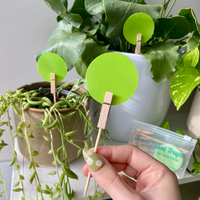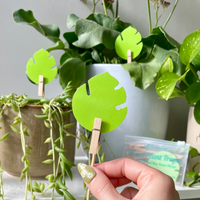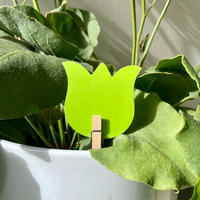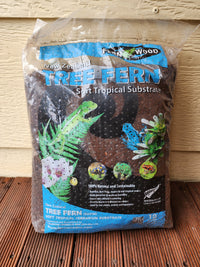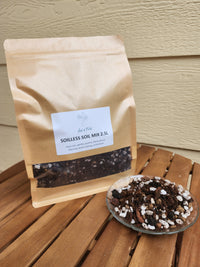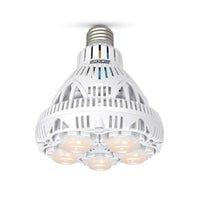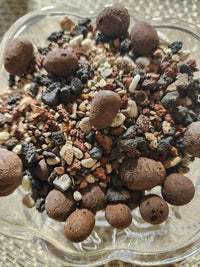Every indoor gardener in Australia faces the frustration of fungus gnats, thrips and whiteflies undermining lush foliage. Leaf of Faith recommends uBloomd sticky traps in Australia for pest-free plants because these eco-friendly, green traps combine colour-attraction science and a special ‘dry’ glue to halt infestations before they spread. In this guide, you’ll discover:
- What uBloomd sticky traps are and how they work
- The key pests they target and signs to watch for
- Why these traps outshine traditional methods in safety, aesthetics and sustainability
- Step-by-step placement, replacement and integration tips
- Long-term benefits for recurring pest control and thriving indoor greenery
What Are uBloomd Sticky Traps and How Do They Work?
uBloomd sticky traps are double-sided, waterproof green cards mounted on compostable wooden sticks that attract flying pests and immobilise them with a proprietary ‘dry’ glue. By emitting a specific wavelength of green light, these traps mimic foliage cues that flying insects instinctively approach. Trapped pests break their life cycle, preventing larvae from developing in soil and safeguarding plant roots.
The Effectiveness of Sticky Traps in Pest Management
Studies have shown that sticky traps are effective in capturing and reducing populations of various flying insects in indoor and greenhouse environments. The effectiveness of sticky traps depends on factors such as the type of glue used, the colour of the trap, and the placement of the traps. Sticky traps are a useful tool for monitoring and controlling pest populations, especially when used in conjunction with other pest management strategies.
What Makes uBloomd Sticky Traps Unique in Australia?
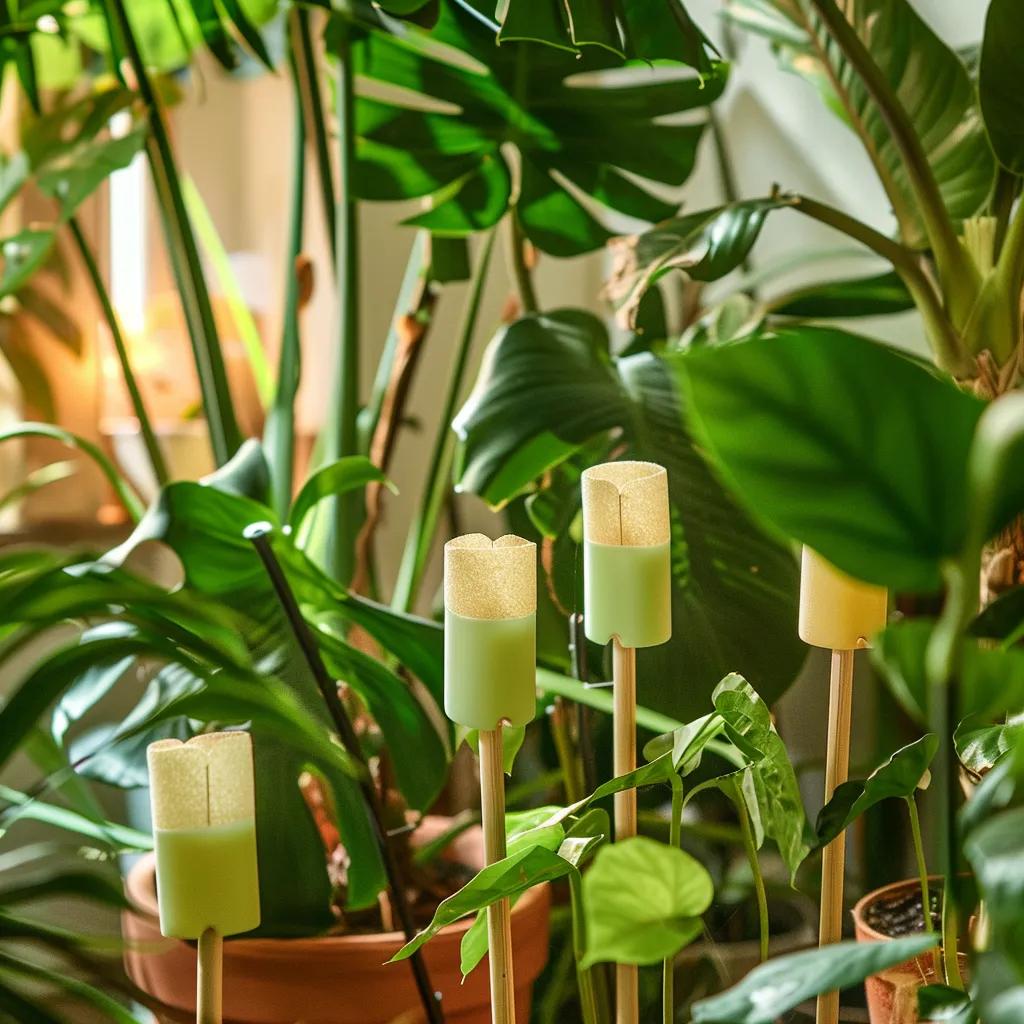
uBloomd sticky traps stand out in Australia through local design, compostable materials and a tailored glue formula. Developed by Australian plant enthusiasts, each trap uses sustainably sourced cornstarch coating and biodegradable supports. This home-grown origin ensures high quality, prompt availability and a solution optimised for our indoor climate. The next section explains how the green colour itself draws pests in.
How Does the Green Colour Attract Common Indoor Plant Pests?
Green attracts fungus gnats, whiteflies and thrips because their photoreceptors are tuned to specific wavelengths that resemble healthy foliage. This visual lure outperforms standard yellow traps, reducing non-target captures and focusing on plant-threatening species. Understanding this mechanism reveals how strategic colour selection enhances trapping efficiency without harmful chemicals.
The Science of Colour Attraction in Pest Control
Research indicates that certain insects are highly attracted to specific colours, such as green, due to their visual systems. This attraction can be exploited in pest control strategies to lure insects towards traps. The use of specific wavelengths of light can enhance the effectiveness of traps by mimicking the appearance of healthy foliage, which attracts pests like fungus gnats, whiteflies, and thrips.
What Makes uBloomd’s Sticky Traps Different?
uBloomd’s traps use a long-lasting adhesive that stays tacky without leaving wet residue. Designed to perform well in indoor plant settings, the adhesive holds up against humidity and dust, making it suitable for use around damp potting mixes. The traps offer a clean, low-maintenance way to help monitor flying insect activity around your plants.
Which Indoor Plant Pests Do uBloomd Sticky Traps Target in Australia?
uBloomd sticky traps excel against a variety of flying pests that plague indoor plants by intercepting adults before they lay eggs. The table below summarises the primary threats and trapping outcomes.
| Pest | Lifecycle Stage Targeted | Trap Impact |
|---|---|---|
| Fungus Gnats | Adult gnats seeking mating | Catches adults, breaks reproductive cycle |
| Whiteflies | Winged adults around foliage | Immobilises beetles before egg-laying |
| Thrips | Adult thrips feeding on leaves | Reduces population and leaf damage |
| Aphids | Winged migrants | Prevents colony establishment |
| Fruit Flies | Adult flies near the soil | Limits new larvae, protects root zone |
Each captured adult reduces future generations of pests, setting the stage for specific lifecycle control techniques.
How Do uBloomd Traps Control Fungus Gnats Effectively?
uBloomd traps control fungus gnats by attracting and capturing adults before they reproduce. This definition, mechanism, and benefit close the gnat’s lifecycle, preventing larvae from feeding on roots and significantly reducing soil-borne damage. Effective placement in moist pots maximises capture rates and halts larval development underground.
Can uBloomd Sticky Traps Catch Whiteflies, Thrips, Aphids, and Fruit Flies?
Yes, uBloomd sticky traps reliably catch whiteflies, thrips, aphids and fruit flies by leveraging green spectrums and adhesive strength.
- Whiteflies become trapped when hovering near new shoots.
- Thrips adhere upon landing to feed on leaves.
- Winged aphids stick during dispersal events.
- Fruit flies collide when skimming the soil surface
Each capture interrupts egg-laying and curtails rapid pest outbreaks, guiding you to monitor soil and foliage for early signs of infestation.
What Are the Signs of Pest Infestation on Indoor Plants?

Signs of infestation include:
- Tiny black specks (gnat adults) hovering at soil level
- White or yellow spots on leaf undersides (whiteflies)
- Silvery streaks or dots on leaves (thrips)
- Sticky honeydew residue and sooty mould (aphids)
- Small maggots in potting mix (fruit flies)
Recognising these symptoms early enables strategic trap placement and swift intervention to protect plant health.
Why Does Leaf of Faith Recommend uBloomd Sticky Traps for Indoor Plant Care?
Leaf of Faith endorses uBloomd sticky traps because they deliver effective pest control, blend seamlessly into decor and support eco-friendly gardening practices. By integrating these traps into your routine, you receive targeted pest suppression, aesthetic harmony and peace of mind without chemicals.
How Effective Are uBloomd Sticky Traps Compared to Other Pest Control Methods?
uBloomd sticky traps outperform conventional oils and sprays by offering continuous, chemical-free protection.
| Product | Feature | Benefit | Advantage | Use Case |
|---|---|---|---|---|
| uBloomd Sticky Traps | Green wavelength | Attracts target pests | Chemical-free, low-maintenance | Indoor pots, hanging baskets |
| Neem Oil Spray | Botanical extract | Inhibits insect growth | Requires regular reapplication | Spot treatment on foliage |
| Chemical Aerosol Spray | Synthetic pesticide | Kills on contact | Potential residue, non-selective | Emergency outbreak management |
Are uBloomd Sticky Traps Safe for Pets, Children, and the Environment?
uBloomd traps use non-toxic glue and compostable materials, ensuring safety around children, pets and beneficial insects. They contain no pesticides or volatile compounds, supporting indoor air quality and ecosystem health. This safety profile means you can place them in any room without risk, maintaining both plant and household well-being.
How Do uBloomd Traps Enhance the Aesthetic of Your Indoor Plants?
uBloomd traps feature a slim, green design that blends with foliage and discreetly sits among branches. Their compostable wooden supports add a natural touch, and cards can be customised in height to suit pot scale. Integrating these traps enhances both plant health and interior styling.
How Do You Use uBloomd Sticky Traps to Achieve Pest-Free Plants?
Using uBloomd sticky traps involves strategic placement, timely replacement and optional integration into broader plant care for maximum impact. Proper deployment ensures continuous adult trapping and monitoring.
What Are the Best Placement Tips for uBloomd Sticky Traps Indoors?
- Insert sticks 2 cm above the soil to catch emerging gnats.
- Position cards near new leaves to intercept whiteflies and thrips
- Hang traps on plant stakes for trailing varieties
When and How Should You Replace uBloomd Sticky Traps?
Replace traps once surfaces are 50 % covered with insects or every 4–6 weeks in high-infestation areas. Gently pull out the wooden stick, fold the card over itself to seal caught pests, and compost the trap. Fresh traps maintain maximum adhesive power and trapping efficiency.
Can uBloomd Sticky Traps Be Combined with Other Plant Care Practices?
Yes, combining uBloomd traps with cultural controls enhances results:
- Reduce overwatering to limit fungus gnat breeding.
- Prune damaged leaves to prevent thrips hotspots.
- Rotate traps around high-risk pots for balanced coverage
What Are the Long-Term Benefits of Using uBloomd Sticky Traps for Indoor Plants?
Consistent use of uBloomd sticky traps builds a barrier against recurring infestations, monitors pest pressure and reduces reliance on chemicals. This sustained approach promotes resilient indoor gardens that flourish season after season.
How Do uBloomd Sticky Traps Prevent Recurring Pest Infestations?
By capturing successive generations of adult insects, uBloomd traps break breeding cycles and limit larval outbreaks in soil. Continuous monitoring flags new pest activity early, allowing prompt action before populations escalate.
How Do These Traps Support Sustainable and Chemical-Free Gardening in Australia?
uBloomd traps align with sustainable gardening through compostable materials, zero-toxin operation and minimal waste. Gardeners contribute to lower chemical runoff, reduced indoor pollutants and a healthier home environment by choosing these traps.
What Do Australian Plant Enthusiasts Say About uBloomd Sticky Traps?
Many indoor plant lovers praise uBloomd traps for clear watermarks of success:
- “My fiddle leaf fig recovered within weeks once the gnats were gone.”
- “I love that the traps blend in and I can compost them afterwards.”
- “No more sticky sprays—my kids and cat are safe around my plants.”
These testimonials underscore real-world effectiveness and delight in using a local, eco-friendly solution.
Leaf of Faith invites you to explore and purchase uBloomd Sticky Traps for lasting, chemical-free pest control and thriving indoor greenery.


